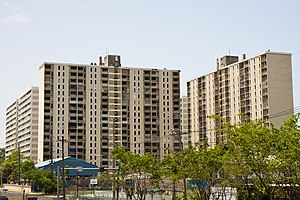
Various issues are believed to affect the availability of affordable housing, although the exact effects are subject to debate:
- Building costs. Buildings made with prefabricated components is one way of reducing costs. More efficient building designs are another method. An A-frame house for example is very cheap to construct, yet (when built) only from wood, has insulation issues (it becomes hot in summer, and cold in winter). Buildings made from pre-fabricated components (ie shipping containers) have the same insulation issues. The issues could be resolved by adding insulation layers[1] Riyad-type constructions (with 4 buildings, and inner courtyard) are suitable for communal buildings, or buildings for large families. Round riyad buildings also exist, see the Round Hakka houses[2] Earthships have suitable thermal properties as well.
- Supply issues:
- Land release. When more land is made available for land, this increases supply. However, meeting demand in this way adds to urban sprawl and makes transport more difficult. Limiting land release, according libertarian/conservative commentator Wendell CoxW, is a major contributor to housing becoming unaffordable,[1] and this is quite logical. If land release is limited for reasons of sustainability and conserving the local environment, it is even more critical to deal very strongly with other factors affecting affordability.
- Housing density. Higher density housing uses less land per residence (or per resident), which should reduce cost substantially. In theory, higher density housing can be cheaper, and allow for cheaper provision of services and public transport. Higher density housing in the form of apartments and terrace housing also has the potential to have lower heating and cooling requirements, if properly designed (an advantage for both affordability and sustainability). Local regulations often prevent this however, through, for example density caps, height limits, Floor Area RatioW and requirements for housing setback. These may have come about due to legitimate concerns, but could arguably be solved in other ways with less restriction on density, thus less restriction on housing supply, and potentially/theoretically lower housing costs. As some of these regulations are often met through landscaping, they do not actually increase the proportion of usable open space.
- Local pressure groups often defend these regulations. There is a problem of differing interests, in that existing residents already own houses and thus do not feel the pressure of housing affordability. In contrast, they may wish to avoid change and the risk of negative change, and to maintain or increase their housing prices. Sometimes arguments are made that young people should buy houses on the fringes; however this is a serious restriction to people's freedom.
Freedom of choice[edit | edit source]
Issues of the free market are unavoidable. Commitment to free market solutions clearly informs some of the arguments above - Wendell Cox, for example, is a strong advocate for the free market, and argues for the freedom to own and drive cars, and to buy land at urban fringes rather than be restricted by urban growth boundaries. Critics consider the economic problems here to be:
- Externalities associated with individual behavior which does not lead to the most efficient group behavior. This comes down to whether cars or public transport are more efficient in time and energy use - the opposing viewpoints tend to disagree on the evidence on this point.
- Environmental impact. The example of NantucketW has been given to illustrate that development restrictions can be effective in protecting an area of great beauty, but at the cost of very high housing costs, and many local workers having to commute from well outside the area. This may be acceptable in rare cases of exceptional beauty and environmental value such as Nantucket, but the inequity and hardship suggests that it should not be acceptable as the general case.
- Current zoning regulations in many Western countries restrict freedom of choice through zoningW regulations which restrict housing supply and prevent medium density, mixed use developments. Supporters of New UrbanismW in particular make these arguments.
See also[edit | edit source]
- A-frame house: cost-efficient design, poor thermal properties[3]
- Shipping container house: cost-efficient design, poor thermal properties (shipping container cost 4000 US dollar/piece)[4]
- http://en.wikipedia.org/wiki/Urban_resilience#Flooding
- Mobile shelter (ie RV, school bus,[5][6] house boat)
References[edit | edit source]
- ↑ NGC documentary: Planet Mechanics: Heavy metal house
- ↑ http://en.wikipedia.org/wiki/Hakka_walled_village
- ↑ Thermal properties can be improved using several techniques, simplest is just adding insulation under walls, adding an air cavity as well is even better yet requires much more money/effort
- ↑ Range complex, featured in Doomsday Preppers
- ↑ Secondhand school buses can be obtained for 300$/piece
- ↑ according to Doomsday Preppers, Ark 2 episode
External links[edit | edit source]
- Why Can't We Build an Affordable House? Witold Rybczynski, The Wilson Quarterly, Summer 2008. (The median new house price in the USA is twice what a Levittowner cost in 1951, relative to the average wage, says Rybczynski. But is this a valid comparison? Levittown houses were considered relatively affordable in 1951, so shouldn't they should be compared with the most affordable segment of marketed offerings today?)